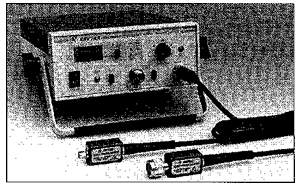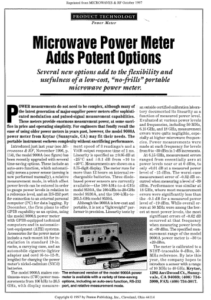This article was originally published in Microwaves & RF article, October 1997.
Several new options add to the flexibility and usefulness of a low-cost, “no-frills” portable microwave power meter.
Power measurements do not need to be complex, although many of the latest generation of major-supplier power meters offer sophisticated modulation and pulsed-signal measurement capabilities. These meters provide enormous measurement power, at some sacrifice in price and operating simplicity. For engineers that fondly recall the ease of using older power meters in years past, however, the model 9000A power meter from KRYTAR (Sunnyvale, CA) may fit their needs. The portable instrument eschews complexity without sacrificing performance.
Introduced just last year (see Microwaves & RF, November 1996, p. 114), the model 9000A (see figure) has been recently upgraded with several time-saving options. These include an auto-zero function, which automatically zeroes a power sensor (zeroing is now performed manually), a relative measurement mode, in which offset power levels can be entered in order to gauge power levels in relation to a reference level, and an RS-232 port for connection to an external personal computer (PC) for data logging. By December, the firm plans to offer GPIB capability as an option, using the model 9000A power meter with GPIB-equipped technical computers and in automatic- test-equipment (ATE) systems. Accessories for the power meter include a rack-mount kit for installation in standard 19-in. racks, a carrying case, and an automobile cigarette-lighter adapter and cord (6-to-12-ft. lengths) for charging the power meter’s nickel-cadmium (NiCd) batteries.

The model 9000A makes continuous-wave (CW) power measurements from 100 kHz to 26.5 GHz, with display measurement speed of 3 readings/s and a V/dB output response time of 1 ms. Linearity is specified as ±0.05 dB at +25°C and ±0.1 dB from +10 to +40°C. Measurements are shown on a 3.75-digit display. The meter runs for more than 12 hours on internal rechargeable batteries. Three diode- based power sensors are currently available—the 100-kHz-to-4-GHz model 9510A, the 100-kHz-to-20-GHz model 9520A, and the 100-kHz-to- 265.5-GHz model 9530A.
Although the 9000A is low-cost and portable, it is not a “lightweight” performer in precision. Linearity tests by an outside certified calibration laboratory documented its linearity as a function of measured power level. Evaluated at various power levels and frequencies, including 50 MHz, 6.15 GHz, and 18 GHz, measurement errors were quite negligible, especially at higher microwave frequencies. Power measurements were made at each frequency for levels from 0 to -39 dBm in 1-dB increments.
At 6.15 GHz, measurement errors ranged from essentially zero at power levels near or at 0 dBm, to only +0.01 dB at a measured power level of -15 dBm. The worst-case measurement error of -0.32 dB occurred when measuring a level of -39 dBm. Performance was similar at 18 GHz, where most measurement errors were significantly less than the -0.1 dB for a measured power level of -19 dBm. While overall errors at 50 MHz were among the lowest at most power levels, the most significant errors of -0.62 dB occurred at that frequency when measuring power levels at -39 dBm. The specified measurement range of the model 9000A power meter is -30 to +20 dBm.


